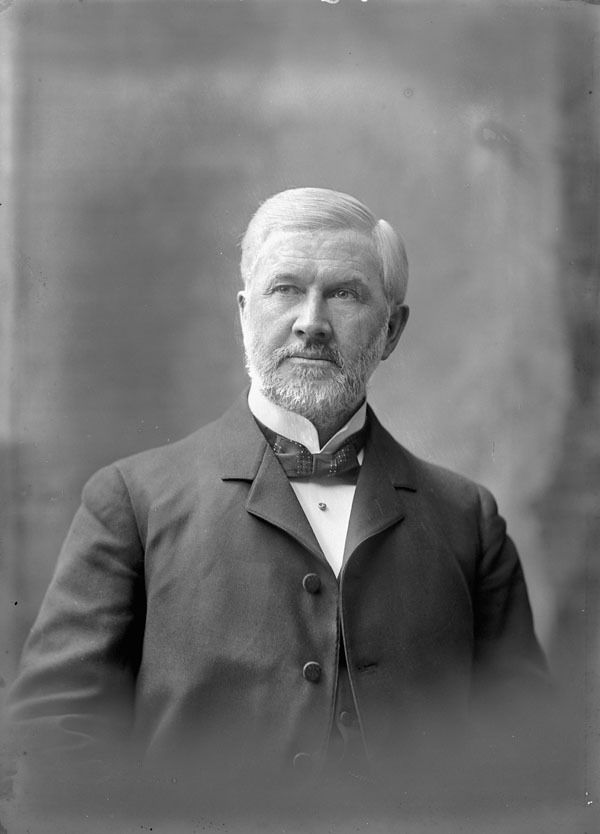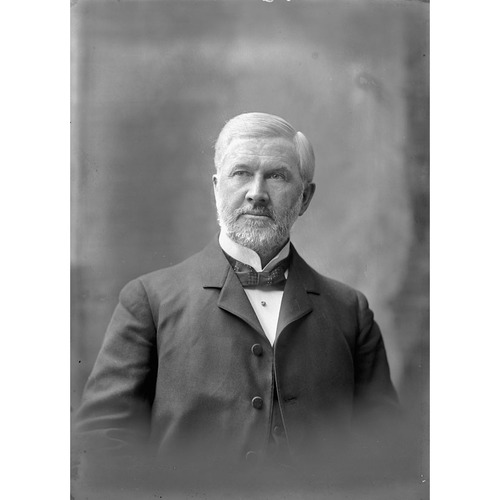BLUE, ARCHIBALD, teacher, journalist, and civil servant; b. 3 Feb. 1840 in Orford Township, Upper Canada, son of John Blue, a farmer, and Mary McTavish; m. first 11 Feb. 1869 Mary Black of Yarmouth Township, Ont., and they had two sons; m. secondly 5 June 1883 Elizabeth Amelia Brabant in Toronto, and they had three sons; d. 27 July 1914 in Ottawa.
Archibald Blue’s father, a native of Argyllshire, Scotland, located in Orford about 1826 under the supervision of Thomas Talbot*. Educated at a public school there, Archibald became a teacher. In 1867 he joined the St Thomas Journal as a journalist and in 1879 he moved to the Toronto Globe as night editor and an editorial writer. The following year he became an editorial writer at the Toronto World. Working for Liberal-leaning newspapers may have brought him to the notice of the provincial government.
In 1881 Samuel Casey Wood, Ontario’s commissioner of agriculture and arts, asked Blue to investigate the benefits of collecting statistics on agrarian production in Ontario, to complete the work of the province’s agricultural commission [see John McMillan*]. Blue’s report of 10 Jan. 1882 stated that agricultural statistics would help producers and consumers to understand markets, farmers to test new methods, and Ontario to attract immigrants by demonstrating its “resources and progress.” On 10 March the province passed legislation creating the Bureau of Industries within the agriculture department, thus becoming the first Canadian province to create a statistical office. Blue was appointed its secretary (head).
By late March he had begun to issue circulars to agricultural societies, township clerks, farmers, local politicians, manufacturers, and other correspondents; from them he requested comprehensive information on subjects that included industrial output, soils, crops, livestock, plant and animal diseases, climate, and fertilizers. The gathering of data was done by schoolteachers and local volunteers. Tables and reports were compiled in Toronto by four full-time and two or three dozen part-time staff. Blue’s first statistical summary, which came out by the end of May, was followed by four “special reports” and a voluminous annual report for 1882. These reports were distributed to the contributors, newspapers, politicians, and emigration agencies. Made deputy minister of agriculture in 1888, when the department gained ministerial status [see Charles Alfred Drury*], Blue expanded his data-gathering system and the range of his tables year by year. His eighth annual report, in 1889, included nearly 300 pages of statistics on such subjects as rents, wages, hours of work, cost of living, and financial statements of loan and investment companies, as well as on agricultural topics.
On 25 July 1888, Blue had been appointed secretary of the royal commission on mineral resources of Ontario. He was responsible for the sections of the final report that dealt with mining laws and proposals for reform, recommendations for assisting the industry, the collection of statistics, and the improvement of mining education. After the commission’s report was completed, in 1890, the government passed legislation on 4 May 1891 which created, within the Department of Crown Lands, the Bureau of Mines to gather and disseminate information on minerals and mining, to administer a revised mining act (including the phasing in of royalties), and to regulate the industry. The next day Blue was appointed its director, although he would continue at the Bureau of Industries until his successor, Charles Canniff James, took over in June.
Blue spent the summer of 1892 building his bureau and touring mines, deposits, and other works. His office would consist of three or four full-time staff, including an inspector with whom he shared the work of checking mines. At first he found it difficult to get mine and quarry owners to cooperate with his statistical endeavours, but he had long been aware of the necessity of site visits to ensure compliance and accuracy of data, and gradually reporting improved. Statistics were only one of his concerns, however. As director, he emphasized the bureau’s regulatory role and its part in instituting changes in policy on resource development. Disturbed, for instance, by the “perfunctory” investigation by the Canadian Copper Company of injurious explosions at its Sudbury works, he would take steps in 1898 to initiate independent coroners’ inquests. He also provided the bureaucratic underpinnings for provincial policy that supported mandatory refining in Ontario and less direct government involvement in development [see Samuel J. Ritchie*]. The most useful form of assistance, he maintained in his report for 1892, was the collection and publication of information on natural resources. In addition to statistics, his annual reports supplied detailed descriptions of mining locations and minerals, and he contributed several technical papers himself. In 1898 the services of his bureau were expanded with the addition of a provincial assay office, where mineral samples could be analysed for a nominal fee.
In 1900 Blue was recruited by the federal government, at a salary almost two-thirds higher than that he had earned in Ontario, to be “temporary” special commissioner in charge of preparations for the census of 1901. When a permanent census and statistics office was authorized within the Department of Agriculture four years later, he was appointed chief as of 1 Oct. 1905. In addition to the application of official statistics to various government activities, such as trade promotion, immigration, and tariffs and subsidies, he managed the census of 1911. It revealed that the dominion’s population had grown over the past decade from 5,371,315 to 7,206,643, “the greatest absolute increase in Canadian history.” Almost half of this growth came from immigration. In 1912 Blue’s office was transferred to the Department of Trade and Commerce, but by then his importance was waning, largely because of his deteriorating health. On the initiative of his new minister, George Eulas Foster*, an internal commission was soon formed to devise a “comprehensive system” for rationalizing the many statistical operations and needs within the federal government. Blue, who was on leave, was not a member of this commission. Following his death he was not replaced – his department had perhaps been doing him a favour by keeping him on full salary – and in 1915 his office would be abolished in favour of a new, central statistical agency, with Robert Hamilton Coats* as Canada’s first dominion statistician and controller of the census.
When he was 72, after a 30-year public career unbroken even by annual vacations, Blue’s health had begun to fail. Medical leaves failed to restore him, and he died in office of heart failure on 27 July 1914. His achievements had been recognized in two ways: in 1892 an American metallurgist studying the nickel deposits at Sudbury named a new mineral blueite in his honour, and in 1908 McMaster University in Toronto awarded him an honorary doctorate.
Archibald Blue and many others of his time believed that counting led to understanding, that a nation’s success could be measured in numbers, and that public policy should be tested and adjusted in an accurate statistical environment. He was a leading Canadian figure in an age fascinated by the apparent precision and potential of statistics.
Archibald Blue’s publications include Resources and progress of the province of Ontario; a paper read before the Commercial Union Club of St. Thomas, November 22, 1887 (Toronto, 1888); The historic method in economics: an address before the section of social and economic science [of the American Assoc. for the Advancement of Science] . . . August 1898 (Salem, Mass., 1898); Colonel Mahlon Burwell, land surveyor ([Toronto, 1899?]); and “Agricultural vs. manufacturing profits,” Canadian Magazine, 23 (May–October 1904): 523–24.
AO, RG 80-5-0-122, no.14652; RG 80-27-2, 8: 105. NA, MG 27, II, D8, 4: 2056–57. Globe, 4 Nov. 1893. Ottawa Citizen, 28 July 1914. Ottawa Evening Journal, 27 July 1914. World (Toronto), 28 July 1914. Can., Fourth census of Canada, 1901 (4v., Ottawa, 1902–6); Fifth census of Canada, 1911 (6v., Ottawa, 1912–15); Departmental commission on the official statistics of Canada, Report (Ottawa, 1913); Parl., Sessional papers, 1900–15, reports of the Dept. of Agriculture, 1899–1914; 1906/7, no.17a (census of population and agriculture of the northwest provinces: Manitoba, Saskatchewan, Alberta, 1906); 1915, no.30: 70. Canadian men and women of the time (Morgan; 1898 and 1912). Nelles, Politics of development, 127–28. Ont., Legislature, Sessional papers, 1880–82, annual reports of the commissioner of agriculture and arts, 1879–81; 1882/83–91, annual reports of the Bureau of Industries, 1882–90; 1892–1900, reports of the Bureau of Mines, 1891–99.
Cite This Article
Gwynneth C. D. Jones, “BLUE, ARCHIBALD,” in Dictionary of Canadian Biography, vol. 14, University of Toronto/Université Laval, 2003–, accessed December 31, 2025, https://www.biographi.ca/en/bio/blue_archibald_14E.html.
The citation above shows the format for footnotes and endnotes according to the Chicago manual of style (16th edition). Information to be used in other citation formats:
| Permalink: | https://www.biographi.ca/en/bio/blue_archibald_14E.html |
| Author of Article: | Gwynneth C. D. Jones |
| Title of Article: | BLUE, ARCHIBALD |
| Publication Name: | Dictionary of Canadian Biography, vol. 14 |
| Publisher: | University of Toronto/Université Laval |
| Year of publication: | 1998 |
| Year of revision: | 1998 |
| Access Date: | December 31, 2025 |




